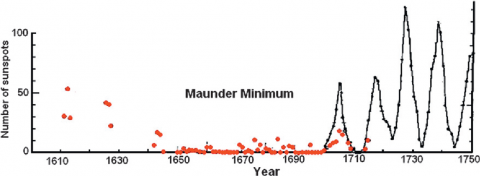Don J. Easterbrook provides more background information on the historical situation at the time of the last low-to-no-sunspot period:
Galileo’s perfection of the telescope in 1609 allowed scientists to see sunspots for the first time. From 1610 A.D. to 1645 A.D., very few sunspots were seen, despite the fact that many scientists with telescopes were looking for them, and from 1645 to 1700 AD sunspots virtually disappeared from the sun (Fig. 1). During this interval of greatly reduced sunspot activity, known as the Maunder Minimum, global climates turned bitterly cold (the Little Ice Age), demonstrating a clear correspondence between sunspots and cool climate. After 1700 A.D., the number of observed sunspots increased sharply from nearly zero to more than 50 (Fig. 1) and the global climate warmed.
FIGURE 1. Sunspots during the Maunder Minimum (modified from Eddy, 1976).The Maunder Minimum was not the beginning of The Little Ice Age — it actually began about 1300 AD — but it marked perhaps the bitterest part of the cooling. Temperatures dropped ~4º C (~7 º F) in ~20 years in mid-to high latitudes. The colder climate that ensued for several centuries was devastating. The population of Europe had become dependent on cereal grains as their main food supply during the Medieval Warm Period and when the colder climate, early snows, violent storms, and recurrent flooding swept Europe, massive crop failures occurred. Winters in Europe were bitterly cold, and summers were rainy and too cool for growing cereal crops, resulting in widespread famine and disease. About a third of the population of Europe perished.
Glaciers all over the world advanced and pack ice extended southward in the North Atlantic. Glaciers in the Alps advanced and overran farms and buried entire villages. The Thames River and canals and rivers of the Netherlands frequently froze over during the winter. New York Harbor froze in the winter of 1780 and people could walk from Manhattan to Staten Island. Sea ice surrounding Iceland extended for miles in every direction, closing many harbors. The population of Iceland decreased by half and the Viking colonies in Greenland died out in the 1400s because they could no longer grow enough food there. In parts of China, warm weather crops that had been grown for centuries were abandoned. In North America, early European settlers experienced exceptionally severe winters.




